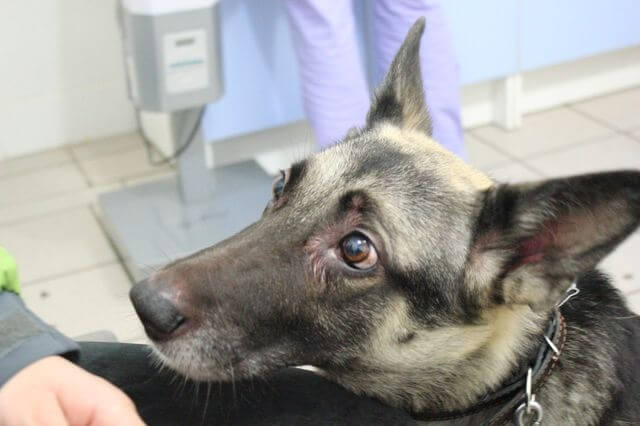Along with diabetes mellitus, it is the most common hormonal disease in dogs: Cushing’s syndrome. In the advanced state, the dog’s appearance changes. The so-called “hanging belly” is characteristic. The good news is that there are promising therapeutic options for certain forms of the disease and early diagnosis. The article provides an overview with the most important information on the subject of “Cushing’s syndrome in dogs”.
Cushing’s Disease in Dogs
Cushing’s syndrome is a hormonal disease that is technically called hyperadrenocorticism. The pituitary gland or adrenal glands are malfunctioning. As a result, the dog’s body makes too much cortisol. Addison’s disease or Addison’s disease, in which too little cortisol is released, has the opposite effect.
The subject of Cushing’s Syndrome is very complex, as the disease has a variety of causes and symptoms. In some affected dogs, the clinical picture is very pronounced, in others, however, hardly. The hormonal disorder occurs in both humans and some animals. In addition to dogs, horses, and, in extremely rare cases, cats can also suffer from it.
Discovery of Cushing’s Syndrome

He is considered the founder of modern neurosurgery: Harvey Williams Cushing († 1939). The American described the disease for the first time at the beginning of the 20th century. Decades later, Cushing’s Syndrome is named after him.
Canine Cushing Syndrome Symptoms
- Above-average craving for food;
- Excessive thirst and frequent urination;
- Development of a hanging stomach (trunk obesity);
- Panting;
- Dull fur;
- Blackheads;
- Bald patches of skin;
- Thin skin;
- Flaccid muscles;
- The weakened immune system, which causes infectious diseases and inflammation;
- In males, the egg-shaped glands can shrink.
In some cases, Cushing’s syndrome in dogs can be the cause of diabetes mellitus.
Canine Cushing Syndrome: Causes
There are several possible causes for the disease. The vet adjusts the therapy depending on the trigger of Cushing’s syndrome.
Spontaneous cause
Cushing’s syndrome can be caused by tumor formation in the control organ of the adrenal gland. A tumor causes the pituitary gland to release too much ACTH (control hormone). Too much ACTH, in turn, leads to an enlargement of the adrenal cortex, so that the production of cortisol increases excessively. In rare cases, a tumor in one or both adrenal glands is the cause of Cushing’s syndrome. This is a functional adrenal tumor that causes the adrenal gland to make a lot of cortisol.
Latrogenic cause
Latrogen means “made by the doctor”. Cushing’s syndrome in dogs can be favored by repeated use of cortisone preparations or by long-term cortisone injections.
Which Dogs Are Prone to Cushing’s Syndrome?
- Basically, any fur nose can be affected, but there are some indicators that increase the likelihood of an illness.
- Females are more often affected by Cushing’s syndrome than their male counterparts.
- Advanced age of the fur nose also increases the risk of developing hormonal dysfunction.
- A breed-specific disposition was observed in the Dachshund, Poodle, Boxer, Beagle, Terrier, German Shepherd, Cocker Spaniel, and Golden Retriever.
Diagnosis: How Does the Veterinarian Diagnose Cushing’s Syndrome?
Increased water intake can also speak for other diseases – such as chronic kidney failure. Therefore, the veterinarian often has to arrange several examinations to determine Cushing’s syndrome in dogs:
- Blood test;
- Urine test;
- Hormone stimulation test;
- Ultrasound examination;
- Computed tomography.
Canine Cushing Syndrome Treatment
The aim of the treatments is to bring the increased cortisol level back to a normal level. The therapy options vary depending on the cause of Cushing’s syndrome. Drug therapy with the active ingredient trilostane suppresses the excessive function of the adrenal cortex. In parallel to the therapy, the blood values must be checked regularly. If the cause is a tumor, surgical removal of the degenerated adrenal gland may be an option. Provided that the risks of the operation are justifiable. In addition, such an intervention should only be carried out by a specialist, since the operation is quite difficult. In the case of a greatly enlarged pituitary gland, radiation therapy can reduce the size of the gland so that a significant improvement occurs. If there is a latrogenic cause for the disease, the drug, which is responsible for the increased release of cortisol, is discontinued in slow steps.
Cushing Syndrome in Dogs – Life Expectancy
If a tumor is the cause of Cushing’s syndrome, a long life expectancy depends on whether the degeneration is benign or malignant. The stage of the disease also plays an important role. It is important for success that the dog owner and veterinarian work well together. If a sick dog is not treated, its quality of life will suffer enormously from the hormonal disorder. Cushing’s syndrome in dogs cannot be cured with drug therapy, but there are still good chances of a long dog’s life.
